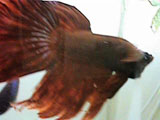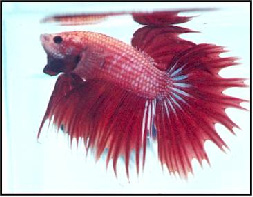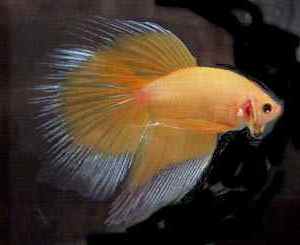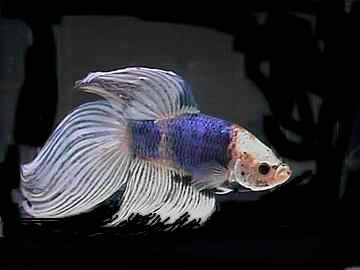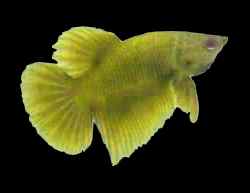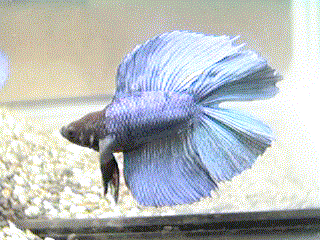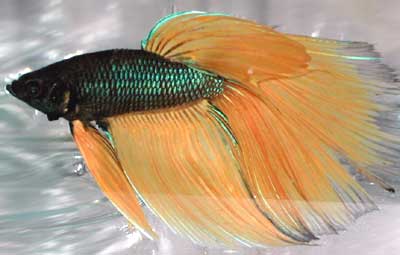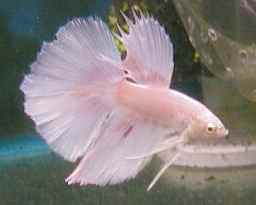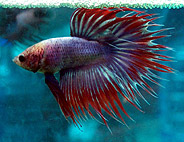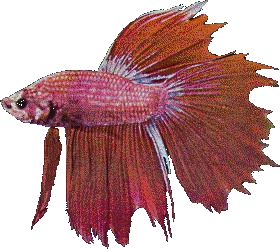| dReds
|
Solid reds are non iridescent colours
and must
have the colour spread evenly over the body. A clean red is
desirable,
without iridescent colours and no fading.
Reds range in hue from beautiful, vermillion reds to deep crimson and red/brown colours. The quality of the colour varies among strains, with most red Bettas showing some iridescence or other colours to some degree. Any opaque overlay detracts from a good
red, giving
rise to muted reds and pinks.
|
| A brilliant cherry red is most desired
in red
Betta
splendens without any iridescence or opaque colour to mask the
solid
red.
The Red Loss factor causes Bettas that
are red
as juveniles to lose that colour as the mature. This factor is
present
in Cambodians and in yellows and apricot
colours.
|
|
Black (melano)
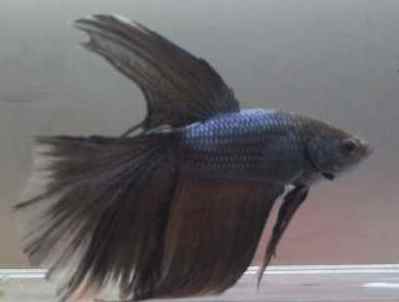 A smoky Melano with some royal blue |
The ideal colour of a true Black Betta splendens
resembles that
of the Black Mollie.
Black in Bettas is often a smoky black. Black Lace forms have transparent, smoky fins. Black is one of the most difficult colours to achieve, as the melano gene produces infertile Black females. Several crosses with other colours have tried to alleviate this problem, e.g. Melano x Celophane or yellows. The Melano x Black Lace lines are infertile; Steel Blue females x Melano males and Royal Blue females x Melano males have produced Blacks with considerable iridescence present. |
| Steel Blue
Double Tailed Steel Blues. Notice the additional rays in the dorsal fin of this Double-tailed type-- a characteristic of the dt gene. |
Steel Blue is also sometimes called Metallic Blue.
This colour has a metallic iridescence when compared to the Royal Blue Betta. Steel Blue results from the allele combination blbl. Steel Blue, Green, Royal Blue, Green and Turquoise Bettas have an interesting genetic inheritance pattern based on the Bl / bl alleles that show incomplete dominance and determine iridescence. Crossings:
|
Green
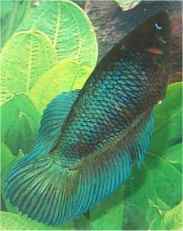 A green RT female. |
Green is the least fixed single colour and varies in shade
from fish
to fish and line to line. Most Green
Betta splendens have
a bluish green hue but less so than a Turquoise variant. It is
often
difficult to distinguish these two hues. Choice greens are dark
green.
This and the turquoise hues derive from the same alleles (BlBl).
The much sought after, dark, forest green is rare.
|
Turquoise
 A turquoise HM males |
A variant of the green, with a distinct blue hue.
Consistent
colour across the fish is rare. The choice colour contains tones of
blue
rather than any Green or Yellow shades, to distinguish them from the
common
green.
Fish with colours close to turquoise are often found in Royal Blue and Steel Blue spawns. The ideal is a dark shade of turquoise.
|
Royal Blue and Corn-flower Blue
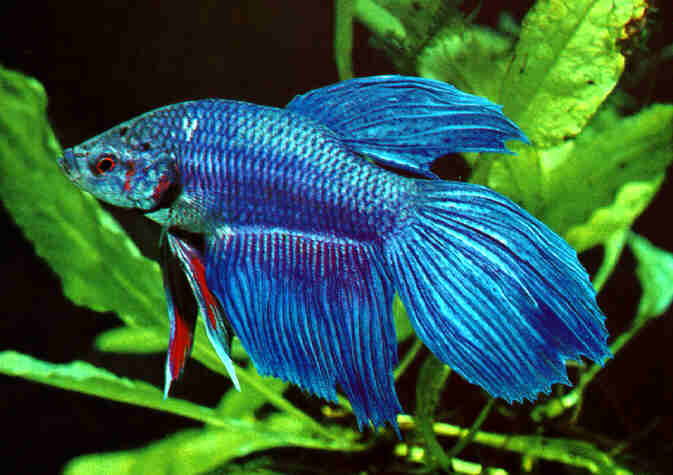
Royal Blue Male Veil Tail |
The consistent, solid royal blue is
the
choice form: the genotype Blbl or blBl gives a deep, rich royal blue in
the green/steel blue/royal blue complex. The most common form has
a dark head and royal blue body and fins. The ideal colour lacks
reds and greens.
Corn-flower blues are the same genotype as royal blues but with a dark head and corn-flower blue body. Royal blues with red factors may appear violet or purple when young and will lose it if the red-loss factor is present and so produce royal blues. Red loss occurs also occurs in Steel Blue, Turquoise, and Green. |
| Yellow
AVT yellow. |
Brilliant lemon yellows or even a butter yellow are the
best
yellow colours produced so far, although some breeders claim to have
produced
a golden yellow. Colours that tend to be either a very pale
yellow
or a yellow-brown tinted are inferior colours.
Yellow results from a gene that transforms red so sometimes the presence of red is also visible. Golden yellow Bettas, with golden iridescence, are rare. In my yellow/apricot strain, only the operculum is iridescent gold. A lutino form exists, in which the eyes are yellow, too. |
Apricot and Peach
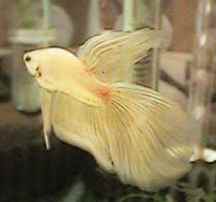 A Peach Male Betta. |
These are yellow pastels of varying intensities.
Apricot yellows have a distinct pale orange tint to the yellow. Some yellow Bettas show a faint orange tint to the fins and are called Apricot. To continue the fruity colours, "Pineapple" Bettas are yellows
with
a
|
| Clear or Cellophane | Has completely transparent fins, with body flesh-coloured; colour from the body organs can cause the fish to look pink. Eyes are pigmented (not albino). |
Albino
 |
Rare. A characteristic of any true Albino fish is that the body lacks all pigmentation, including the eyes which appear red. Like Cellophane, these are completely colourless fish and may appear pinkish white or solid white if the opaque factor is present. True albino Bettas have red eyes, with no pigmentation. |
| White (Not albino)
|
Some solid, white Bettas are a truly beautiful dense white
due to the
Opaque factor. Whites may have black eyes if they are not albino.
The image, left, shows blue due to the colour rendering. The fish is white. Whites of this type have black eyes.
|
| Opaques (Pastels)
|
The Opaque allele gives the fish a milky white overlay that
dilutes
the underlaying colours to pastel shades, including the eye colour in
most
cases.
There is an opaque form of each of the main colour types if the Op allele is present. White Opaques appear dense white to opaque steel blue. Pastels can be almost any pastel colour.
|
| Chocolate
|
Chocolate Betta splendens look brown to the eye, but
are actually
a black and yellow mix.
Chocolate variants can be bred to yellow to improve colour of
both the
yellow and the chocolate fry.
|
Orange
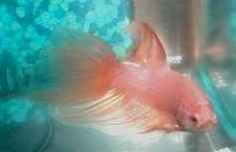 Orange Betta |
Orange Bettas are a new strain of Betta splendens, and
concepts
of "orange" varies with individual breeders. I have not seen any
true orange Bettas in Australia, except for light reds that look more
vermillion/orange
than true orange and yellows that have a slight wash of
orange/red.
How "orange" is orange? Perhaps an agreed colour chart would help distinguish true colour classification. |
| Lavender, Purple and Violet
|
A lavender Betta is genetically a Cambodian Betta
splendens
with extended Red and a layer of light iridescent blue-green.
Truly Purple Betta splendens are also very new and rare and it appears that the colour results from blending red and blue. My Royal Blue strain throws purple or violet fry that appear violet at their first show of colour and darken to royal blues within a few months, as the red fades (due to the red-loss factor, L) as the fish mature . Truly violet coloured Bettas are rare. |
